Yesterday was a good day for raptors in western Utah County. I saw Red-tailed Hawks, Ferruginous Hawks, Rough-legged Hawks, Northern Harriers, Prairie Falcons, American Kestrels and a single Golden Eagle and subadult Bald Eagle.
But my best photos were of a beautiful male Rough-legged Hawk as it took off from a power pole. The sky was kind of a weird shade of blue but I was able to get 10 unclipped images of the bird in flight and I present 7 of them here, in sequence and with no “skips”.
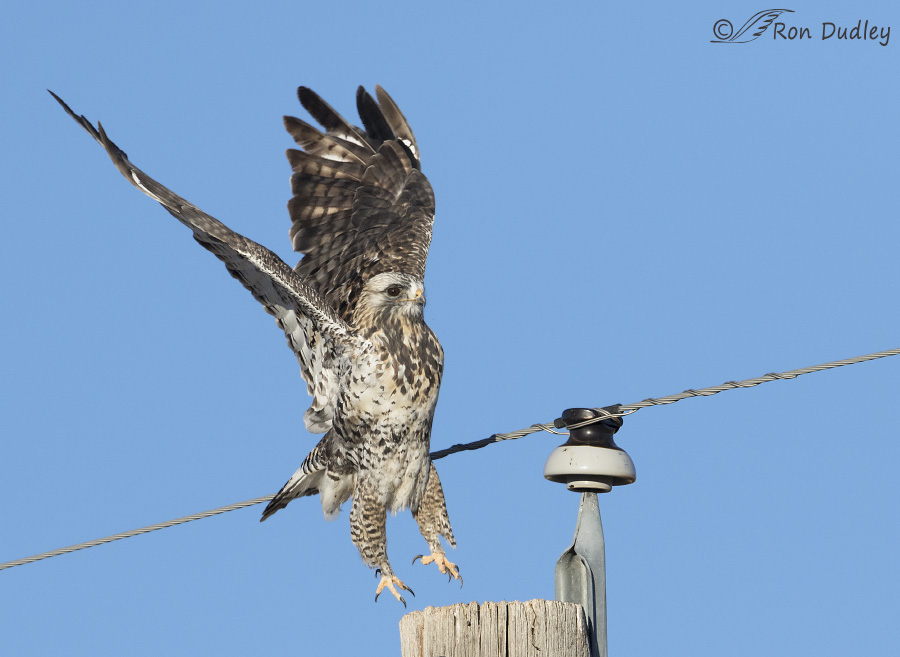 1/3200, f/7.1, ISO 500, Canon 7D Mark II, Canon EF 500mm f/4L IS II USM, not baited, set up or called in
1/3200, f/7.1, ISO 500, Canon 7D Mark II, Canon EF 500mm f/4L IS II USM, not baited, set up or called in
It launched almost straight up, apparently to avoid the transmission line.
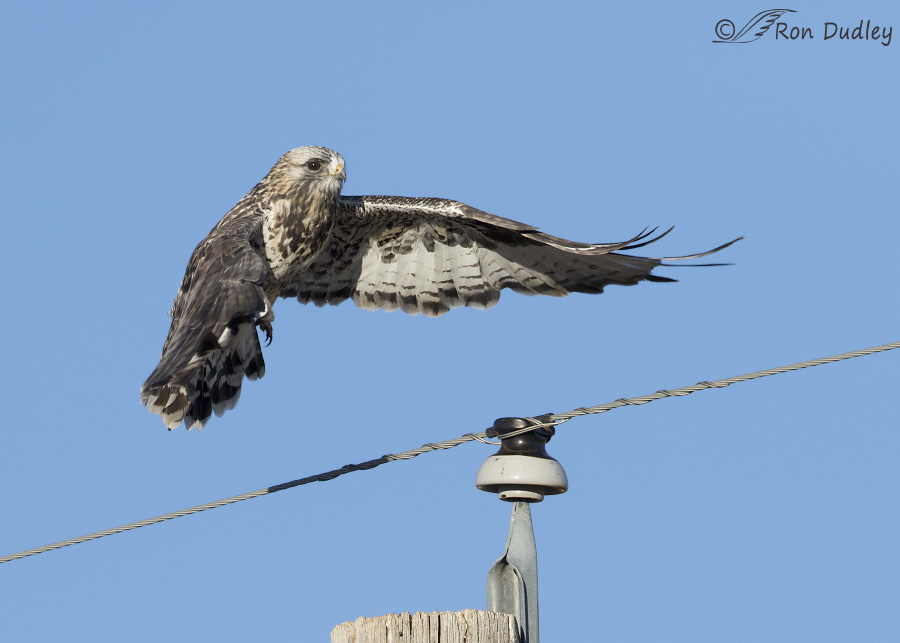
1/3200, f/7.1, ISO 500, Canon 7D Mark II, Canon EF 500mm f/4L IS II USM, not baited, set up or called in
I cropped the next image as I did to include the top of the pole so that viewers could see that the hawk actually jumped up and slightly backward as it first took off. I thought that was at least slightly unusual. I actually anticipated that the bird might go over the top of the wire and it’s a good thing I did or I’m sure I’d have clipped wings or other body parts in many of these first shots.
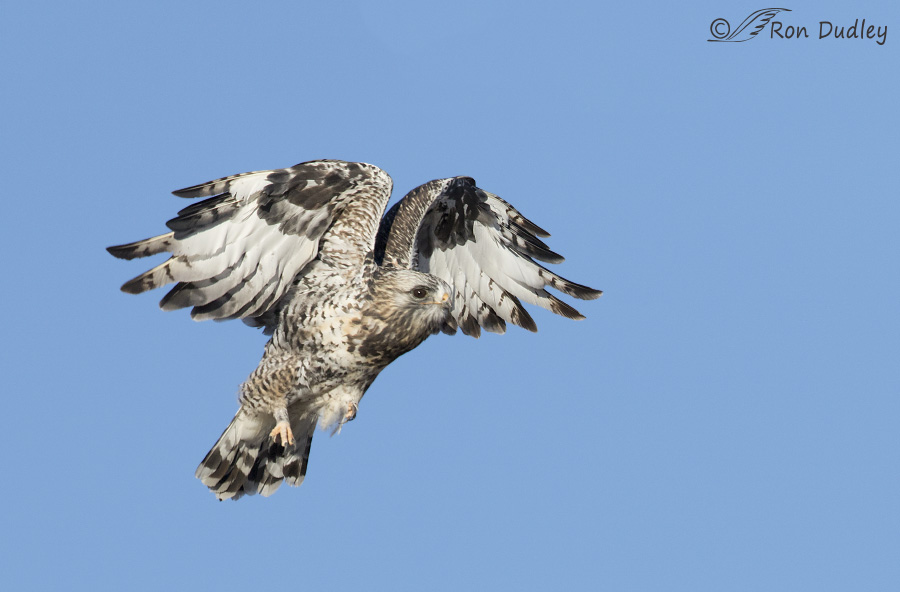
1/3200, f/7.1, ISO 500, Canon 7D Mark II, Canon EF 500mm f/4L IS II USM, canvas added for composition, not baited, set up or called in
I believe this flight posture to be due to the fact that because of its vertical jump it had no forward momentum at this point.
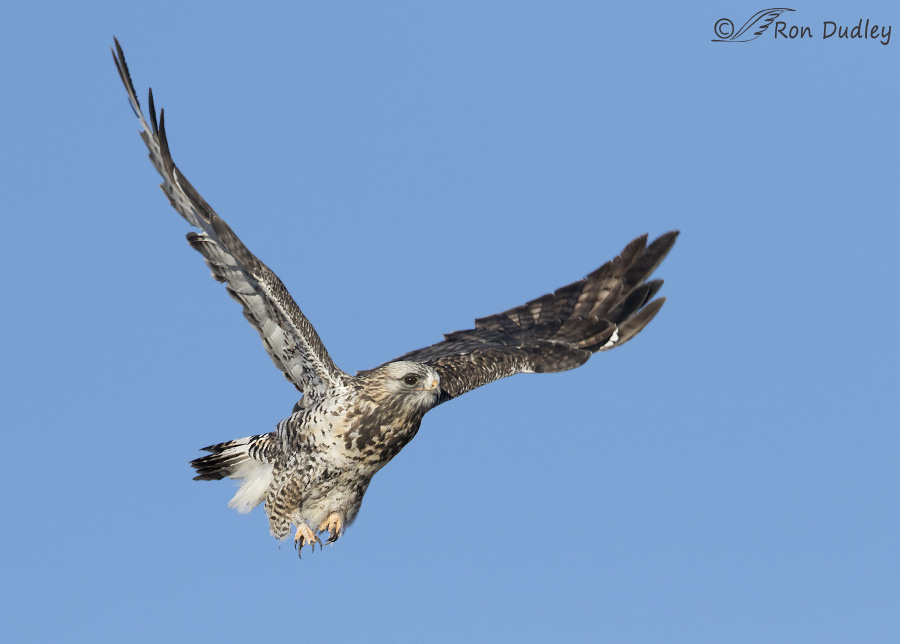
1/3200, f/7.1, ISO 500, Canon 7D Mark II, Canon EF 500mm f/4L IS II USM, not baited, set up or called in
But he was able to quickly build up speed.
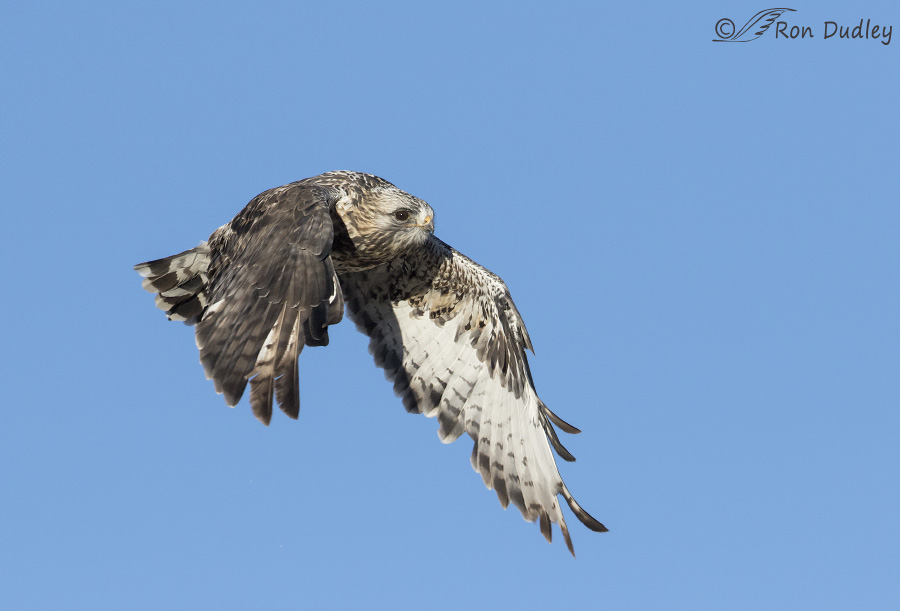
1/3200, f/7.1, ISO 500, Canon 7D Mark II, Canon EF 500mm f/4L IS II USM, not baited, set up or called in
The power line was just below him in these images but I was able to crop them out without doing any cloning.
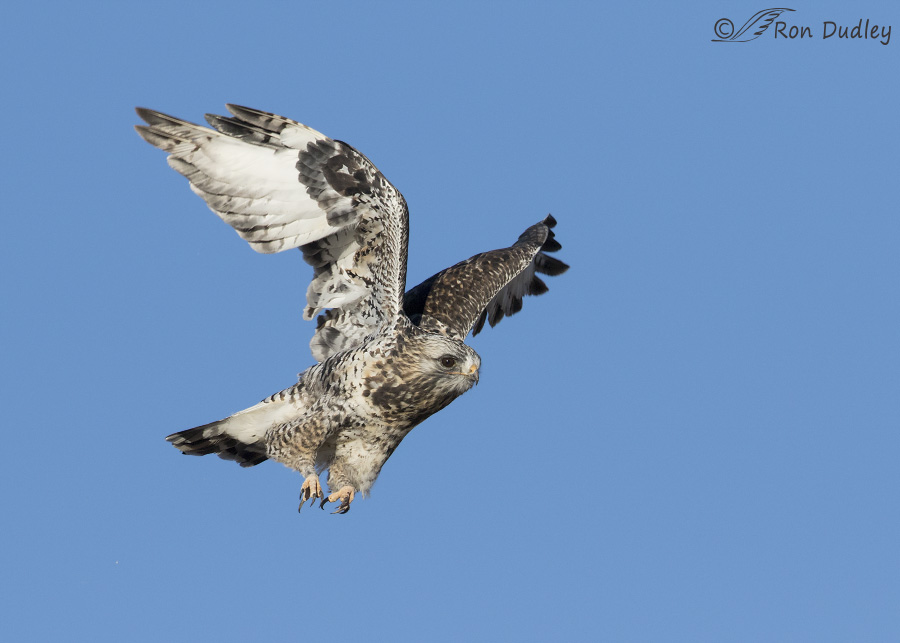
1/3200, f/7.1, ISO 500, Canon 7D Mark II, Canon EF 500mm f/4L IS II USM, not baited, set up or called in
Here we see the “rough legs” and proportionately small bill and feet the species is known for – all adaptations to cold arctic life (heat conservation).
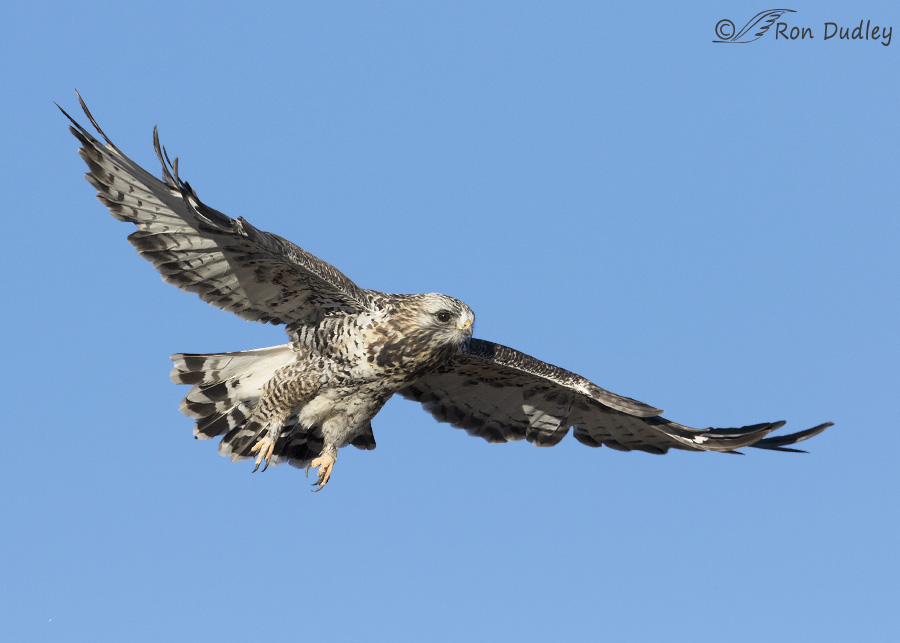
1/3200, f/7.1, ISO 500, Canon 7D Mark II, Canon EF 500mm f/4L IS II USM, not baited, set up or called in
In this final image the hawk has finally built up enough momentum that its wings are extended rather than pumping for air speed. This might be my favorite shot of the bunch but there are things I like about some of the other images too.
Rough-legged Hawk populations are known to be nomadic as they move around in response to the availability of their rodent (largely voles in winter) prey. Last year was a relatively slow winter for them around here and I believe that was a result of a decline in the naturally cyclic population of voles. This winter looks promising for Roughies so far and I couldn’t be happier about that.
Ron


I think I like the “stall” the best (third photo). Beautiful beast.
His first 3 primaries seem to be growing in. Is that any help in aging him?
“Is that any help in aging him?”
I don’t know, Pam. I’m out of my league with that question. Perhaps someone else knows…
This is an adult male based on plumage Pam, but hard to age beyond that from the photos.
Thanks Neil.
His flying ability with the wires and poles makes him look like an adult.
We only get them in winter in Madison, WI. I saw my first one last winter and then noticed them gathering to move north early in our spring. They were pretty and variable raptors.
One of the most variable in plumage Pam, no two seem to be exactly alike!
Amazing series of shots Ron! Thanks for sharing!
Charlotte
Thank you, Charlotte.
EIGHT species of raptor in one day (morning). Wow, wow and wow. And happy dances. Love Patty’s take on its britches too.
Yes, it was a special raptor day for me, EC. I didn’t get very close to some of them but just seeing them was pretty neat.
Hi Ron, another set of images and associated text that would work perfectly in that field guide I keep hoping you’ll write! Beautiful!
Cheers,
Dick
Ha, I don’t even have time to keep my image files culled, updated and backed up, Dick. A book just isn’t going to happen I’m afraid. I sure appreciate your confidence in me though…
An absolutely gorgeous series. The shot that got to me the most was the first one, I think because I could feel the stretch. The last one comes next on my list. Glad you had such a good day yesterday.
“Glad you had such a good day yesterday”
Me too, Susan. That day has been a very long time coming with Roughies.
I’m curious about the time frame of your shots? I don’t know much about rough-leggeds, but it looks like the first three primaries on each side (or last three, depending on whether you’re an ornithologist or a falconer) are still growing in, indicating a late summer time? Or are those feathers shorter on a rough-legged? I’m also curious if there was wind involved in the backward part of that takeoff?
Either way, what a gorgeous series of shots! I love seeing raptors’ super powers in action!
Laura, there was no wind and these images were taken yesterday morning.
It does appear that the bird is finishing up it’s molt Laura, and quite a bit later than usual as you point out! Neat stuff!
Beautiful series of shots.
Thank you, Ashley.
Awesome series Ron! Hoping to see/photograph Rough-legged hawk before spring. For now i enjoy them via you posts!
I hope to have many more posts this winter featuring Roughies, Carl. Time will tell…
This id a beautiful series…can really see how athletic they can be and how well they can manuver…great views of their unusual “snow pants” (AKA britches) too….
Thank you, Patty.
Nice to see your daily posts again Ron and also to see Rough-legged Hawks in them. The sequence is great. The markings on the RLHA’s are beautiful.
Thanks so much, Ed. And I agree that the markings on this bird are really neat.
Recent satellite telemetry work has shown Rough-legs are surprisingly faithful to their wintering grounds from year-to-year, but may be less so to their breeding grounds. While some individuals do move between wintering grounds, many have been shown to return to the same general area in consecutive winters. Great shots Ron!
Neil, I got that info from the AMNH Birds of North America but the satellite telemetry you cite would be more current and presumably more accurate. Thank you for providing it. BTW, I really appreciate the work you and others do at Hawkwatch International.
Thanks Ron, and yes the satellite telemetry work has only occurred in the last 2 years. Up until now we knew relatively little about this species movements patterns but are learning a great deal through this current work, mostly being conducted by folks in California and Nevada. To date the work has shown that perhaps Rough-legs are not as nomadic as once thought, but additional years of data will help tell the full story.
Thanks for this info, Neil. Strictly anecdotal, but this helps explain why there are “good” (I.e, reliable) places to see Rough-legs in the Klamath Basin very winter. In addition, there is one location that always seems to have dark morph birds (I saw one yesterday). I have wondered what was attracting the dark birds – I guess they are just being faithful to the same wintering grounds. I’m looking forward to hearing the results of that research, since I bird northern CA on a regular basis very winter. Thanks again!
Cheers,
Dick
Thanks very much for the additional info, Neil. Very interesting!
Gorgeous set – you can really see the effort being put into the downbeat, great series Ron.
To your knowledge does this rough look to you like a cross between a dark and light phase?
“does this rough look to you like a cross between a dark and light phase?”
Thanks, Dick. To be perfectly hones I’m not very knowledgeable on raptor color phases so I think it best to leave that determination to others with more experience. Makes me wonder though…
Dick: This is what some folks call a ‘heavily marked’ light-morph. Rough-legs are notoriously variable in their plumage and sometimes that line between light and dark is a tough one to call.
Many thanks Neil.
It seems interesting to me with all the DNA research that is being done on ALL animal and plant life that we should be able to narrow down some of the genetic differences within species that have definite color phases and whether the developing grades are due to what mating sequence. Oh well further research to be done I gather.
There is actually a PhD student currently studying Rough-legged Hawk genetics and plumage variation in California, so we should know more soon! Because Rough-legs breed mainly in the high arctic, an area that is difficult to access, little work has been done on this subject. For instance, I observed a dark-morph female mating with a light-morph male in Alaska several summers ago, but was not able to stick around to see what color-morphs the fledglings turned out to be. We know a lot about this subject with other arctic breeding raptors that are popular in falconry, like the Gyrfalcon, but Rough-legs are not a popular falconry bird.
Thanks again Neil! Very interesting stuff!!
If I were a young guy today this is research I would be obsessing to tackle!
Neil, I’ve often wondered what color morphs the youngsters are when the three main morphs of Swainson’s Hawks cross – whether there was a genetic pattern there or not. For example, if light morphs and dark morphs cross are the youngsters intermediate morphs, or can you get all three morphs in their offspring? Swainson’s aren’t a popular falconry bird either but since they breed further south in less remote areas I suspect the answer is known. It’s just that I don’t know it…
Wonderful sequence, Ron! Their beaks and feet are small – probably wouldn’t be a problem as a “chicken hawk” Beautiful bird.
Beautiful bird.
Thanks, Judy. I think those small bills are part of what makes them such handsome birds.